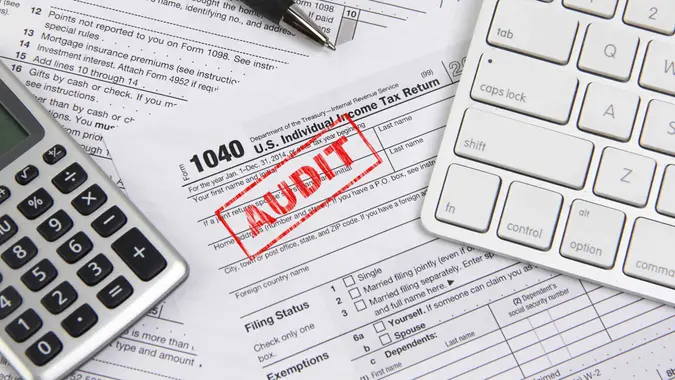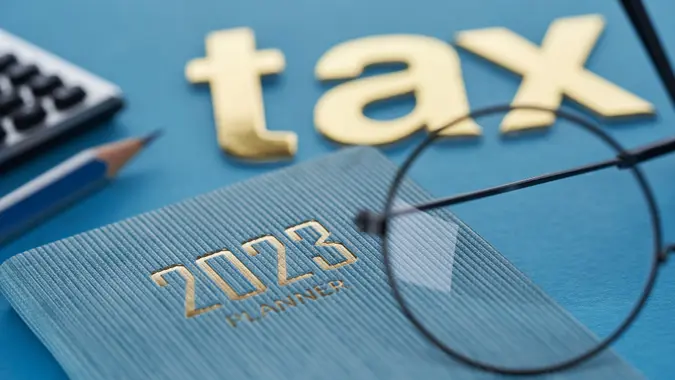5 Taxes That Might Surprise Retirees

Commitment to Our Readers
GOBankingRates' editorial team is committed to bringing you unbiased reviews and information. We use data-driven methodologies to evaluate financial products and services - our reviews and ratings are not influenced by advertisers. You can read more about our editorial guidelines and our products and services review methodology.

20 Years
Helping You Live Richer

Reviewed
by Experts

Trusted by
Millions of Readers
How common sources of income are taxed is one of the most overlooked aspects of retirement planning. If you’re like many Americans, you may have a number in mind as to how much you want to accumulate by the time you retire. But if you don’t factor in the taxation of your income after you retire, the number you have in mind might fall short of providing you with the lifestyle you want.
Social Security
Social Security may seem like a benefit that should not be taxed — and for some Americans, it isn’t. However, the percentage of Americans who don’t pay any tax on their Social Security benefits is low. If you’re a single person and your combined income is between $25,000 and $34,000, you’ll owe tax on up to 50% of your benefits. But if you earn over $34,000, then you’ll owe tax on as much as 85% of your benefits.
If you’re a joint filer, the same principle applies, but the income brackets are higher. Joint filers pay tax on up to 50% of benefits with incomes between $32,000 an $44,000, with incomes above $44,000 subject to tax on up to 85% of benefits.
Pension
Your pension is somewhat like a 401(k) plan, except only your employer contributes to it. As your employer gets a tax deduction for any contributions it makes on your behalf, all of the payments that you receive will be fully taxable at ordinary income tax rates.
One of the few exceptions is with pensions that you make after-tax contributions to, although again this is fairly rare. In that case, the portion of your payments that represent your return of capital will not be taxable.
Retirement Plan Withdrawals
In most cases, retirement plan withdrawals are fully taxable as ordinary income. This is true for 401(k) plans and traditional IRAs, along with a host of other retirement plans that are less common, from 403(b) plans to 457 plans and others. Even if your earnings in a retirement plan come from capital gains, your withdrawals will still be taxed as ordinary income.
One of the few exceptions to this rule is a qualified withdrawal from a Roth IRA. Contributions to a Roth IRA are made with after-tax money, but all qualified withdrawals — including earnings — are tax-free. After-tax contributions to a 401(k) plan also can be withdrawn tax-free in retirement, although the earnings attached to those contributions cannot.
Annuities
The taxation of annuities can get complicated, but essentially there are two types you should know about: qualified and nonqualified.
Qualified annuities are funded with pre-tax money, just like a traditional IRA or 401(k) plan. Thus, when you take a distribution from a qualified annuity, all of the money you withdraw is fully taxable as ordinary income, since none of it has ever been taxed.
Nonqualified annuities are funded with after-tax money, much like Roth IRAs. This means that when you take a distribution, only the earnings portion of your withdrawal will be taxed. Your after-tax contributions can be taken out tax-free.
Capital Gains
Capital gains in retirement are taxed the same way as they are before you retire. For gains held one year or less, you’ll be taxed at your ordinary income tax rate. For gains held longer than one year, you’re entitled to the more advantageous long-term capital gains rate, which is typically 15%. However, you can drop that rate as low as 0% based on your income.
For tax year 2022, the income threshold for the 0% capital gains rate is $41,675 if you’re single or married filing separately, $55,800 for those filing as head of household and $83,350 if you’re married filing jointly or a qualifying surviving spouse.
Although this doesn’t apply to most Americans, high earners may have to pay a long-term capital gains tax rate of 20%. Depending on your filing status, here are the income thresholds for the 20% long-term capital gains tax bracket:
- Singles: taxable income greater than $459,750
- Married filing jointly or qualifying surviving spouse: taxable income greater than $517,200
- Head of household: taxable income greater than $488,500
- Married filing separately: taxable income greater than $258,600
Bear in mind, however, that in a few rare instances, long-term capital gains tax rates can be even higher. Specifically:
- Any recaptured Section 1250 gain from selling Section 1250 real property: 25%
- Net gain from selling collectibles, such as coins and art: 28%
- The taxable part of a gain from selling Section 1202 qualified small business stock: 28%
More From GOBankingRates
 Written by
Written by  Edited by
Edited by 
























